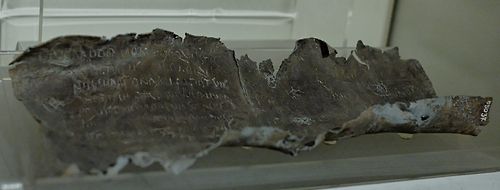One English translation of defixio (plural: defixiones) is ‘curse tablet,’ though they are not necessarily used only for harmful magic. This common name comes to us by way of French from the Latin ‘defixionis,’ but the practice itself originates in Ancient Greece, where the term is katadesmos (κατάδεσμος). Both words describe a ‘binding.’
At core, a defixio is a spell written into a physical medium and then disposed of ritually. In its most traditional form, a Greek katadesmos would be an invocation of a deity composed in verse and etched into a thin tablet of lead.
The tablet would then be buried in some place where it wouldn’t be disturbed. Burying an item for a spell magically “fixes” it in place. So this method is perfect for binding spells, as well as spells intended to preserve something as it is.
If the desired effect is to bind or harm someone, Hekate is a likely deity to call upon for help in curses and bindings, but a defixio may just as easily call upon any deity, or no deity at all if you choose.
Today, it’s more difficult to source lead tablets, not to mention our greater awareness of the dangers of working with lead, so any other material will work just as well. I usually will write a little verse on plain paper, fold it up on itself, and close it with sealing wax.
These can then be buried to bind their purpose, or kept until the desired effect comes to pass and then buried or burned. I collect mine someplace safe and private until I burn them in a ritual fire at Samhain to leave that aspect of the old year in the past.
A paper defixio may also be burned immediately to release your intent into the universe. A method best for a spell meant to produce an immediate change, as opposed to a binding.

Leave a Reply